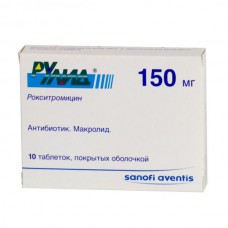Expiration date: 12/2025
Rulid
International name:
The Roxithromycin (Roxithromycin)
Group affiliation:
Antibiotic, macrolide
Description of the active substance (INN):
The roxithromycin
Dosage form:
dispersible tablets [for children], tablets coated
Pharmacological action:
Semi-synthetic antibiotic group macrolides for oral administration. Has bacteriostatic action: binding to 50S ribosome subunit, inhibits translocation reaction and transpeptidation, the process of formation of peptide bonds between amino acids and peptide chain inhibits protein synthesis by ribosomes, resulting in inhibits the growth and reproduction of bacteria. Sensitive to the drug: Streptococcus group A and b, including Streptococcus pyogenes, Streptococcus agalactiae, Streptococcus mitis, Streptococcus saunguis, Streptococcus viridans, Streptococcus pneumoniae, Neisseria meningitidis, Moraxella catarrhalis (Branhamella), Bordetella pertussis, Listeria monocytogenes, Corynebacterium diphtheriae, Clostridium spp., Mycoplasma pneumoniae, Pasteurella multocida, Ureaplasma urealyticum, Chlamydia trachomatis, Chlamydia pneumoniae, Chlamydia psittaci, Legionella pneumophila, Campylobacter spp., Gardnerella vaginalis. Irregular sensitive: Haemophilus influenzae, Bacteroides fragilis and Vibrio cholerae. Resistant Enterobacteriaceae spp. Pseudomonas spp. Acinetobacter spp. Stable in acidic media.
Indications:
Infections of the upper and lower respiratory tract (pharyngitis, bronchitis, pneumonia, bacterial infection in COPD, panbronchiolitis, bronchiectasis), respiratory tract (tonsillitis, sinusitis, otitis media), skin and soft tissues (erysipelas, phlegmon, furuncles, folliculitis, impetigo, pyoderma), urinary tract (urethritis, endometritis, cervicitis, vaginitis, including sexually transmitted infections, except gonorrhea), oral cavity (periodontitis), bones (periostitis, chronic osteomyelitis), scarlet fever, diphtheria, whooping cough, trachoma, migratory erythematous rash, brucellosis. Prevention of meningococcal meningitis among people who have been in contact with the patient. Prevention of bacteremia in patients with endocarditis after dental surgery.
Contraindications:
Hypersensitivity, simultaneous intake of ergotamine and dihydroergotamine, pregnancy, lactation, infancy (up to 2 months).C caution. Liver failure.
Side effects:
Nausea, vomiting, loss of appetite, change of taste and/or smell, epigastric pain, diarrhoea (rarely with blood), flatulence, increased activity "liver" transaminases and alkaline phosphatase, cholestatic or hepatocellular acute hepatitis, pancreatitis, pseudomembranous enterocolitis, dizziness, headache, paresthesia, allergic reactions (bronchospasm, urticaria, rash, hyperemia of skin, angioneurotic edema, anaphylactic shock), development of superinfection, candidiasis of the mouth and vagina, pigmentation of nails.
Overdose:
Treatment: gastric lavage, symptomatic treatment, specific antidote exists.
Method of application and dose:
Inside, adults - 150 mg 2 times a day, morning and evening, before meals or 300 mg once. The course of treatment is 5-12 days with respiratory diseases and LOR-organov to 2-2.5 months in chronic osteomyelitis. If chlamydia and Mycoplasma pneumonia - 14 days, if legionellae pneumonia - up to 21 days. When liver failure - 150 mg 1 time per day. Children (suspension) - 5-8 mg/kg/day (depending on body weight, the type of pathogen and the severity of the infectious process), not more than 10 days. The suspension is prepared immediately before use the measuring spoon filled with water and put it in 0.5 or 1 tablet for suspension preparation for intake when the tablet will disintegrate into small pellets, just to give the child to drink water.
Special instructions:
When liver failure to monitor liver function.
Interaction:
Increases the absorption of digoxin. Increases the prothrombin time when administered simultaneously with warfarin or phenprocoumon. Increases T1/2 and AUC midazolama (amplification and increase of duration of action). Increases concentration in plasma theophylline, cyclosporine A (does not require correction of dosing regimen). Increases serum concentrations of astemizole, cisapride, pimozida, that leads to prolongation of the interval Q-T and/or severe arrhythmias (ECG monitoring). Can displace disopyramide from plasma proteins, leading to increase in its concentration in the blood serum. Ergotamine and ergotaminopodobnykh vasoconstrictor drugs lead to the development of "ergotism", the tissue necrosis of the extremities.


